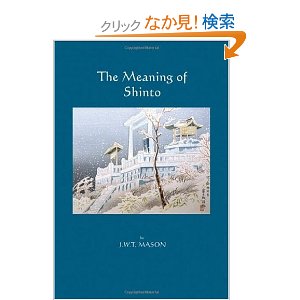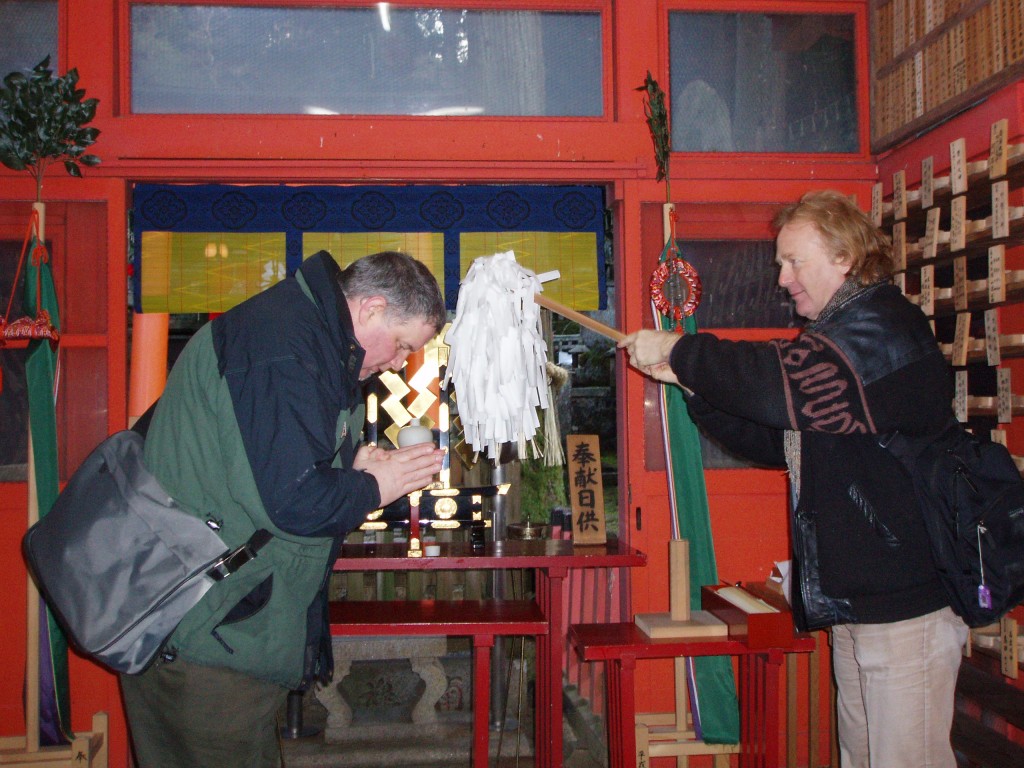‘The Meaning of Shinto’ by J.W.T. Mason Canada: Tenchi Press, 2002 179 pages. ISBN 155369139-3 $17.00
This is a reprint of a 1935 publication by a respected writer on spiritual traditions. The foreword is by Ann Llewellyn Evans, priestess at Bright Woods Spiritual Centre & Kinomori Jinja in British Colombia, who was responsible for the reprint. One can understand the need for republication. As well as explaining the philosophical basis of Shinto, Mason makes a forceful case for its universalism. His main emphasis is on life as a divine self-creative development, a monist belief that he thinks the West would do well to learn from. Much of the book is concerned with interpreting Kojiki mythology and early history, though there are also sections on modern times and the influence of Shinto on Japanese culture in general. The writing is at times abstract and repetitive, yet for the reader who perseveres there is much rewarding material.
The book is remarkable in a number of ways. Firstly for the sensitive way in which Mason unpacks Shinto. Secondly, for the way in which he places it at the centre of Japanese culture, more or less at the exact time as Suzuki was doing the same thing for Zen (Zen and Japanese Culture was first published in 1938). Suzuki’s book went on to become hugely influential in the spread of Zen to the West; by contrast Mason’s book was little known.
Quote follows: “Shinto’s ‘narrow nationalism’ is due to the fact that it began as an explanation of the history of the Japanese race’s origin and early development, and expresses its intuitive knowledge of reality in terms of the Japanese nation. This, however, is fundamentally no more than a method of presentation. Everything that is basic in Shinto can be explained in ways applicable to the universe, not only to Japan. ‘Narrow nationalism’ is not Shinto because Shinto is universal in its concepts. Those who interpret Shinto as being limited to Japan in its comprehension of life do not understand Shinto.” (p.177)
“Those who interpret Shinto as being limited to Japan in its comprehension of life do not understand Shinto.” I wish Mason was still alive: he’d be able to put a few people straight! You can’t help wondering how the ideas would have been received by Mason’s Japanese friends. His epitaph for instance was written by Inoue Tetsujiro, an imperialist who argued that Christians were traitors to the national ideology ( though he was beaten very badly by fanatics – he lost sight in one eye – because he wrote that the imperial jewels were replicas, the genuine items having been lost at sea when the emperor Antoku drowned after his ship was sunk in the 12th century.)
In response to my enquiry on the H-Japan mailing list, John Breen posted a short piece about Mason as follows:
“Thanks to John Dougill for his posting on Mason and Shinto. I don’t know much about the man, but I did write a short piece on him. Mason, an American who worked as the New York correspondent for the Daily Mail for a while, wrote numerous books and articles on Shinto in English and in Japanese. His main argument seems to have been that Japan owed its successful modernisation to Shinto, and this because Shinto guaranteed the freedom of the individual and encouraged individual endeavour to a degree which Western philosophy could not. The key was the Shinto teaching that the spirit of the kami resided in all of human kind. As you say, John, Mason regarded Shinto as being nothing less than the key to the further development of civilisation.”


John,
Great website. Very interesting post on J.W.T. Mason. I imagine shrine Shinto must have been very nationalistic when the book was first published. Were all shrines caught up in that fervor or did some resist? Considering how deeply the Meiji establishment were invested in Shinto mythological history, is it any surprise that Shinto was co-opted in a nationalist way.
The photos on your site are also excellent. I was particularly intrigued by the one accompanying this post. Are you performing a purification ritual with magic gohei wand? The wand seems to be having a powerful affect on your devoted recipient.
Paul
Magical indeed!
Can you do that for me too, Dougill sensei? I’ve got my `yakudoshi` this year! I’ve been cursed. Terrible.
Hiroko, be glad to oblige any time… Omiwa Jinja has haraigushi available for self-purification and is rather a magical place with an ancient tradition. You can walk up the sacred hill too in a kind of pilgrimage to the sacred rocks at the top. That would get rid of your curse for sure!
Dougill sensei,
Haraigushi sounds nice. I could get some for my friends, too, who were born in the same year. I guess there are many `Omiya Jinja’ around Japan. Which one do you refer to?
Hiroko, Omiya Jinja would be a funny tautology. I was referring to Omiwa Jinja, near Sakurai. I’m sure you know it, don’t you… the one with the snake kami and the egg offerings…
Oops. I’ll check Omiwa jinja, then!
Interesting.
I just finished “The Meaning of Shinto” and after this review, and the clear introduction by Ms. Evans, I was expecting great things. Clearly, Ms. Evans must feel the book is meaningful and important to reprint it, and she says so in the Introduction.
Considering that I have some respect for both Mr. Dougill’s and Ms. Evans’ understanding of Shinto, I have to believe that I’ve missed something, or that I don’t have some needed frame of reference to understand something key in this book.
I had to constantly remind myself, “This was written in 1935. Product of it’s time.” The prose is dense and thick. Some of the assumptions seemed to be right there in the superior Western view of the poor primitives. (Mr. Mason never did say “primitive savages” but I was expecting it.) There were a couple of obliviously sexist viewpoints as well, which is to be expected from that time.
I think one of the very dated assumptions made in the book was that “primitive” races weren’t capable of complex understanding or self-analysis. I found the entire idea that Japanese culture was not “self-concious” to be laughable. This is the same culture that was writing the the Kojiki while “advanced Western civilization” was in the middle of the Dark Ages. They were as capable of self-concious thought as the Chinese and Indians they got other influences from, and made different choices.
It was also clear that Mr. Mason really loved Shinto, and Japan, and the Japanese culture. Some of the style and arguments in the book may have been to enlighten people of his own day and overcome some of that same “primitive savages” attitude that Western society had at that point, and to convince his peers that Japan was not lost in the Orient, but a modern society to be treated as equals.
If I understand properly, the book was released during the rigid control of State Shinto. The government was stopping “dissident thinkers” which may also have affected how the book was written, and what Mr. Mason and his sources could say. Many of the statements about Shinto’s “narrow nationalism” conflicted with what propaganda would shortly say about Japan and Shinto.
While I found several memorable quotations in the book which I liked and will extract, I found it difficult reading, and didn’t get the same big picture and importance others did.
Now I’m wondering what I missed.
This Mister Mason was a verry wise person.
“Those who interpret Shinto as being limited to Japan in its comprehension of life do not understand Shinto.”
Truly excellent. Sadly, it seems most Japanese have a verry limited understanding of Shintoism, because they are not verry pious nowadays, and when they were, it was mostly for the kind of superstitious things which caused Mencken’s mockery, qualifying it as primitive, and saying most educated japanese will go for Confucianism or Buddhism instead.
Thank you for the comment. In response I would say that the dominant trend nowadays is of an incremental return to State Shinto and the notion of Shinto as a national rather than universal religion. This is of course being fostered by a government of extreme nationalism under prime minister Abe, which has already severely curtailed individual rights and now seeks to boost Japan’s military outreach.
I just spotted a translation of this book in a Japanese catalog of books about Shinto. I guess the locals are reading it to understand their own religion.